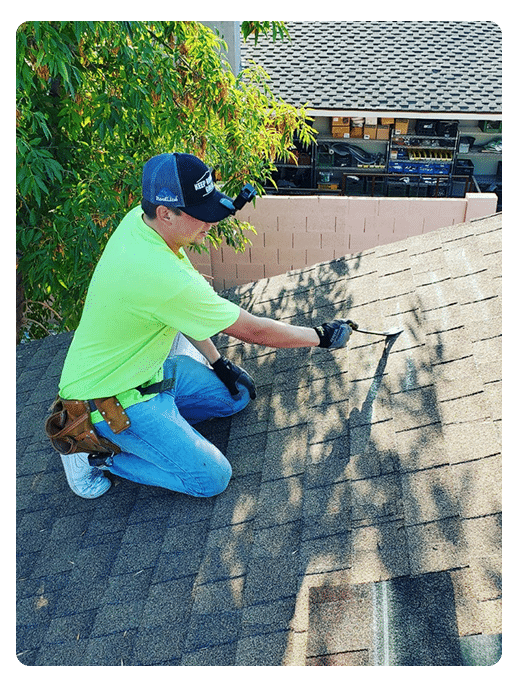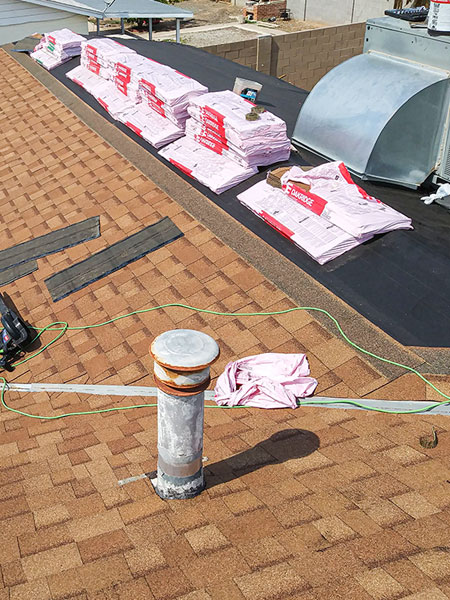Roofing damage is a costly and potentially dangerous issue. Understanding the various types of roofing damage can help prevent serious problems from developing in the future.
It is important to be aware of what signs to look for when inspecting roofs, as well as how each type of damage should be addressed accordingly. This article will provide an overview of the different types of roofing damage, exploring their causes and symptoms.
Additionally, it will offer suggestions on how best to identify potential issues before they become more severe. With this information, readers can gain insight into understanding and preventing further roofing problems that could lead to costly repairs or replacement down the road.
Water Damage
Water damage is one of the most common types of roofing damage that can occur. It may be caused by rain, snow, hail, or other forms of moisture accumulation on the roof surface. The effects of water damage range from discoloration to structural weakening if left unchecked for a long period of time.
To detect water damage in its early stages it is important to pay close attention to the appearance and condition of your roof when inspecting it. Visual indicators such as dark spots, sagging areas, cracked sealant, and moss growth should not be ignored as these are often signs that there has been some form of water infiltration into the materials used for the roof structure.
Additionally any leaks around vents or flashing should also be addressed quickly before further deterioration occurs. Taking preventive measures such as keeping gutters clear and using waterproof membranes on sections prone to contact with moisture can help reduce the likelihood of having issues related to this type of damage in the future.

Wind Damage
Wind damage is one of the most common forms of roofing damage. It can result in a variety of problems, ranging from total destruction to minor wear and tear.
Wind-driven rain and ice can cause water infiltration, which leads to structural decay and rot. Additionally, strong winds can blow off shingles or tiles, leaving bare spots on your roof that are vulnerable to further deterioration.
To spot wind damage, look for loose or missing parts such as damaged flashing around skylights, chimneys, vents, or other penetrations; cracked seals around flashings; deteriorating felt underlayment or tar paper; broken shingles or tiles; and sagging along ridges and eaves.
Take note of any visible signs of damage so you can address them accordingly with repairs or replacements.
Damage From Hail
Wind damage is a common cause of roofing damage, but hail can be just as destructive. Hail causes more localized and concentrated damage than wind since it falls in one spot at a time.
The most obvious signs of hail damage are dents or bruises on the surface of the roof material, however there may also be less visible signs that require closer inspection.
The impact from hailstones can break asphalt granules off the shingle surface, leaving bare patches exposed to weathering and other physical abuse over time. This makes them vulnerable to moisture intrusion which could lead to further problems such as rot or mold if left unchecked.
Additionally, some types of roof materials like metal roofs may have holes punched into them by larger sized stones causing water to leak through directly onto whatever lies below.
It’s important for homeowners to inspect their roofs after any severe storm for these telltale signs before repairs become expensive and extensive.
Missing Or Damaged Shingles
Missing or damaged shingles are a common roofing problem that can cause significant damage if left unchecked. Without regular maintenance, the integrity of a roof structure is compromised and any moisture intrusion can quickly lead to even more serious issues.
It’s important for homeowners to keep an eye out for missing or damaged shingles on their roofs in order to prevent further deterioration and costly repairs. Signs of missing or damaged shingles include granules from the asphalt material washing away, bare spots where shingles should be attached, warped areas, buckling due to water accumulation, mold growth around the ridge line, and gaps between individual shingles.
If any of these signs are present it’s essential to contact a professional roofer as soon as possible so they can assess the extent of the damage and provide the best solution for repair. Delaying necessary repairs only puts your home at risk of additional damage due to water infiltration.
Flashing Damage
Roof flashing damage is an issue that should be taken seriously, as it can lead to serious problems if left unchecked.
Flashing is a barrier between the roofing material and any other materials used in construction, such as walls or chimneys. It helps keep water from seeping into your home through these areas, which could cause extensive damage over time.
To spot this type of damage, inspect the areas where different materials come together on the roof for signs of wear or breaks in the flashing sealant. Additionally, look out for evidence of water pooling around these areas and leaking inside your home.
If you do find signs of flashing damage, contact a professional roofer immediately so they can assess the situation and provide an appropriate solution before more significant issues arise.
Structural Damage
When it comes to roofing damage, flashing is not the only concern. Structural damage is another major issue that needs to be assessed and addressed. This type of damage involves any kind of deterioration or disruption of the foundation or structure of a roof system. Depending on the severity, structural damage can compromise the integrity of a building and put those inside at risk.
Signs of structural damage include visible signs such as:
Buckling
Sagging
Cracking
Leaking ceilings
Unleveled floors
Loose shingles
Mold growth in certain areas
It is important to have an experienced inspector look for these signs when assessing potential structural damage. In addition to visual inspections, professionals may use advanced tools such as infrared imaging cameras to detect moisture intrusion beneath surfaces due to water infiltration from damaged roofs which could cause further structural problems if left untreated.
It is critical that homeowners take action immediately if they suspect any form of structural damage on their property’s roof since this type of damage has both short-term and long-term consequences that can be costly to repair. Taking preventive measures now will ensure greater safety for those living within the building in the future.

Leaking Roofs
Leaking roofs are a common issue for homeowners and can be caused by many different factors. Poor installation, age, weather damage, or even poor maintenance over time can all lead to roof leaks.
It is important to identify the source of any leak before attempting any repairs as this will help determine what type of repair is necessary and how best it should be addressed.
One way to spot leaking roofs is to look out for water marks on walls or ceilings in rooms below the roof. If left untreated these spots may become larger with time and may indicate that there is an active leak above them.
Additionally, you might notice softening patches in your insulation where water has been able to seep down into the material from the attic space above it.
In general, if you suspect that your roof might have a leak then it is always best to seek professional advice about possible solutions and potential repairs needed.
Conclusion
The roof of any building is a critical component, and it requires regular maintenance to stay in good condition. To ensure the integrity of a roof, one must be able to identify different types of damage that can occur over time.
Water damage, wind damage, hail damage, missing or damaged shingles, flashing damage, structural damage and leaking roofs are the most common causes of roof failure. Ignoring these problems could lead to costly repairs down the road. Therefore, understanding the signs and symptoms associated with each type of roofing problem will help property owners diagnose potential issues before they become too severe.
Taking proactive steps such as inspecting a rooftop regularly for evidence of wear and tear should go a long way towards preserving its longevity.


